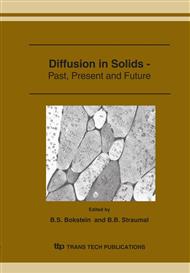[1]
J. Philibert: Atom Movements: Diffusion and Mass Transport in Solids, (Editions de Physique, Les Ulis 1991).
Google Scholar
[2]
A.R. Allnatt and A.B. Lidiard: Atomic Transport in Solids, (Cambridge University Press, Cambridge 1993).
Google Scholar
[3]
J.R. Manning: Diffusion Kinetics for Atoms in Crystals. (Van Nostrand, Princeton, NJ 1968).
Google Scholar
[4]
G.E. Murch and J.C. Dyre: CRC Crit. Rev. Sol. St. Mat. Sci. Vol. 15 (1989), p.345.
Google Scholar
[5]
A.R. Allnatt: J. Phys. C: Solid State Phys. Vol. 14 (1981), p.5453 and p.5467.
Google Scholar
[6]
C.C. Wang and S.A. Akbar: Acta Metall et Mater. Vol. 41 (1993), p.2807.
Google Scholar
[7]
M. Nastar, V. Yu. Dobretsov and G. Martin: Phil. Mag. A Vol. 80 (2000), p.155.
Google Scholar
[8]
J.R. Manning: Phys. Rev. B Vol. 4 (1971), p.1111.
Google Scholar
[9]
L.K. Moleko, A.R. Allnatt and E.L. Allnatt: Phil. Mag. A Vol. 59 (1989), p.141.
Google Scholar
[10]
T. Wichmann, K.G. Wang and K.W. Kehr: J. Phys. A: Math. Gen. Vol. 27 (1994), p. L263.
Google Scholar
[11]
B. Widom: J. Chem. Phys. Vol. 39 (1963), p.2808.
Google Scholar
[12]
G.E. Murch and R.J. Thorn: J. Comput. Phys. Vol. 29 (1978), p.237.
Google Scholar
[13]
M. Bowker and D.A. King: Surf. Sci. Vol. 72 (1978), p.208.
Google Scholar
[14]
G.E. Murch and R.J. Thorn: Phil. Mag. Vol. 36 (1977), p.529.
Google Scholar
[15]
G.E. Murch: Phil. Mag. A Vol. 46 (1982), p.151.
Google Scholar
[16]
K.W. Kehr, K. Binder and S.M. Reulein: Phys. Rev. B Vol. 39 (1989), p.4891.
Google Scholar
[17]
G.E. Murch and R.J. Thorn: Phil. Mag. A Vol. 39 (1979), p.259.
Google Scholar
[18]
A.R. Allnatt: J. Phys. C Vol. 15 (1982), p.5605.
Google Scholar
[19]
Z. Qin and G.E. Murch: Phil. Mag. A Vol. 70 (1994), 481.
Google Scholar
[20]
H. Sato and R. Kikuchi: J. Chem. Phys. Vol. 55 (1971), p.677.
Google Scholar
[21]
P. Argyrakis and A.A. Chumak: Phys. Rev. B Vol. 66 (2002), p.54303.
Google Scholar
[22]
G.E. Murch: Phil. Mag. A Vol. 41 (1980), p.157.
Google Scholar
[23]
R. Kutner: Phys. Lett. A, Vol. 81 (1981), p.239.
Google Scholar
[24]
G.E. Murch: Diffusion in Crystalline Solids, ed: by G.E. Murch and A.S. Nowick (Orlando, Fl. Academic Press 1984) p.379.
Google Scholar
[25]
R.A. McKee: Phys. Rev. B Vol. 23 (1981), p.1609.
Google Scholar


